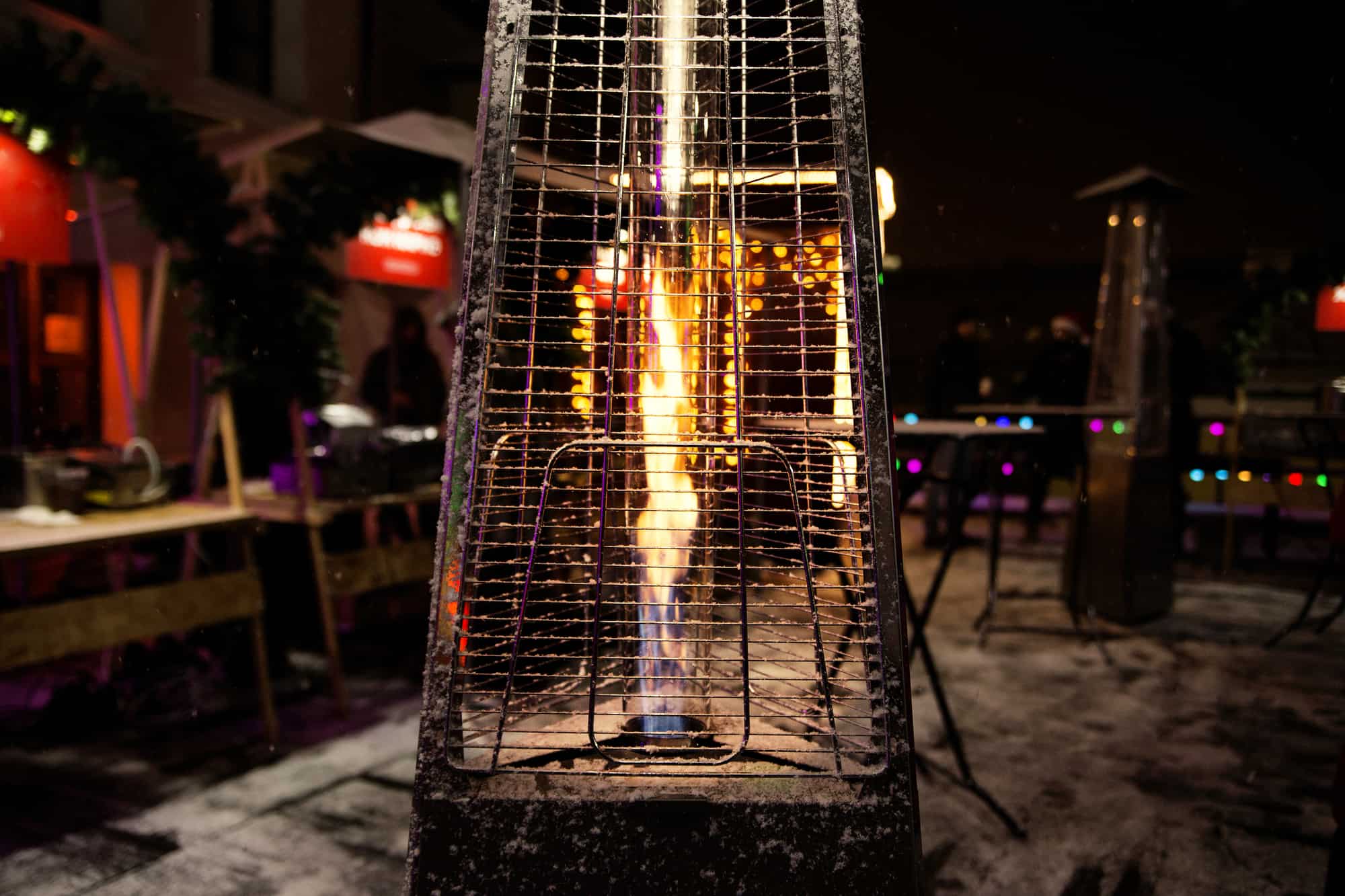Outdoor heaters can be the difference between spending your evenings cooped up on the couch and enjoying the fresh air outside. The problem is there are so many options available it’s hard to know how to pick one.
Between patio heaters, fire pits, and pyramid heaters — which is best?
Pyramid heaters are best for most people because they produce considerable warmth over large areas, pose the lowest fire-risk, and add style and ambiance to their surroundings. Still, you can’t beat fire pits if you’re looking for a cheap, communal, full-sensory experience.
There isn’t one outdoor heater that is ideal for everyone. Every model has its own unique benefits and drawbacks. In this article, we’ll take you through each kind and let you know what kind of value they may add to your outdoor time.
Patio Heaters: A Basic Overview
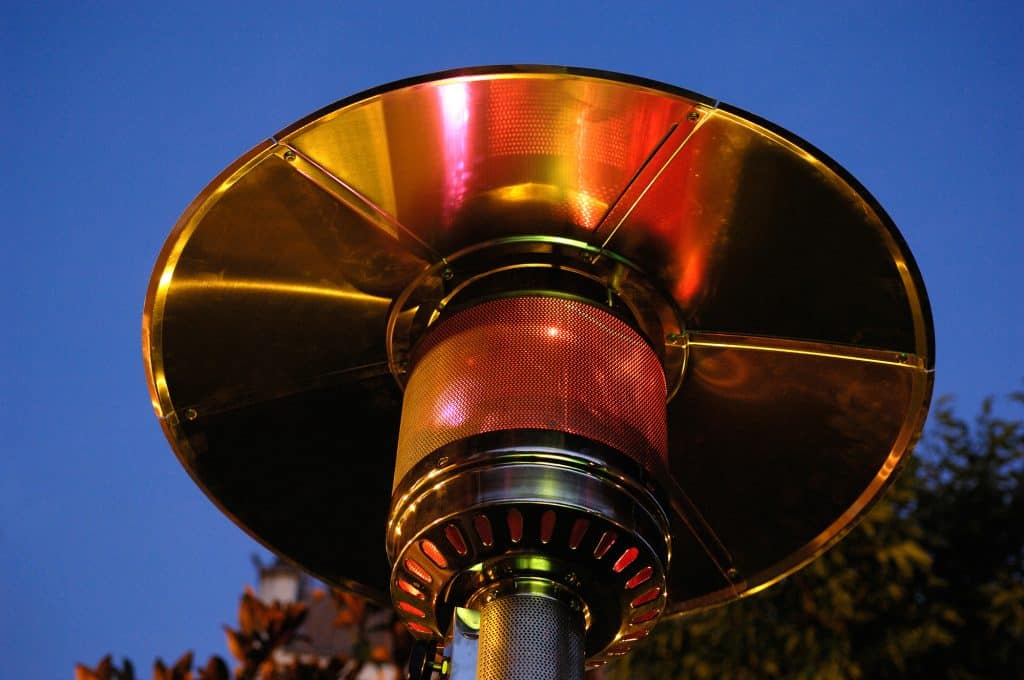
Patio heaters are great alternatives to standard wood-burning fires. These warmers come in various models, so you can guarantee you’ll find one that works for you and your space.
Whether you’re looking for a small, portable heater that you can set on tabletops or a tall, permanent fixture to hook up to your natural gas line, you’ve got it.
Patio heaters also come in various degrees of British thermal units (BTU), so you can choose a strength that perfectly accommodates your needs. Ideally, your heater will provide about 5,000 BTUs for every 100 square feet (9 square meters) of space you want to cover.
Pros of Patio Heaters
Patio heaters offer tons of advantages. Here are some of them:
- Come in propane and natural gas varieties. The fuel choice is up to you when it comes to patio heaters: propane or natural gas. Propane comes in refillable tanks that are pretty pricey, but you can move the heater around if you desire. Natural gas burners tap into pre-existing lines and burn cleaner than wood. These tend to be more expensive as they require professional installation but pay off in the long run.
- Patio heaters can easily be used in winter. Since they can function perfectly in most conditions, it’s easy to use a patio heater in cold, snowy months. You can warmly enjoy the entire year outside on your deck or by your backyard rink with these heaters. Set up some chairs and sip some nog while the kids play! How dreamy!
- You can usually leave this outside in most weather. Since patio heaters are suitable for year-round use, they’re usually weather-proofed too. These should always be turned off whenever you aren’t using them, especially wind or precipitation. Still, you can leave them alone outside in any condition.
- Patio heaters are smokeless and lack an open flame. One of the patio heaters’ biggest benefits is that they don’t have those standard fire pit downfalls: smoke and flames. While these can be desirable qualities for some, patio heaters require less attention and have fewer associated risks—no more smokey eyes for you.
- They can be very portable. Heaters that run on propane are easy to move around to your desired location. This is highly beneficial if you have a few areas you’d like to heat (at alternate times) but don’t want to dish out the money for multiple heaters. Wherever you go, they can go, within reason, of course.
- Patio heaters come in various sizes, and some are even tabletop friendly. You’ll have many options to choose from when shopping for patio heaters. Different varieties include wheeled, stationary, hanging, mounted, and tabletop. No matter where you are or what kind of area you want to warm, there’s certainly a product you’ll love.
Cons of Patio Heaters
Despite their benefits, patio heaters maintain some flaws. Consider these drawbacks before going all-in:
- Top-heavy patio heaters are more fall-prone than pyramids. The most significant drawback of patio heaters is that many aren’t overly steady. This can be a big safety hazard, especially if you have small children of large dogs who may knock it over. Lots of models indeed promote anti-tilt technology, but you should always be careful near the heater. Some people even secure the base with sandbags or bungee cords.
- They are not overly aesthetically-pleasing. Honestly, many patio heaters aren’t that nice to look at. Mushroom head models have a bulky base, thin pole shaft, and umbrella-like top. Their typical metallic shine gives these heaters a robotic appearance. If you can look past aesthetics, they can be a great companion, but if you’re in it for the beauty, patio heaters may not be the way to go.
- Wind is an enemy of patio heaters. Remember what we said about the construction of these appliances? Well, the umbrella or mushroom-like head and thin pole body make them highly susceptible to getting knocked down and taken by the wind. Patio heaters do not do well in such conditions and should be used with caution.
- Patio heaters create less ambiance than alternatives. You won’t get to enjoy the beauty of an open flame if you choose to warm yourself with one of these models. Unlike pyramid heaters, the only place you’ll ever see a warm orange glow is at the very top, under the umbrella head. You can think of these as tall, industrial-style floor lamps, not ambient orbs to gather around.
- Natural gas and propane are easily combustible. Another danger of patio heaters is that their fuel is incredibly flammable. This, combined with their tendency to fall, makes them a potentially hazardous choice. Always read the manufacturer’s instructions on how far away to keep flammable objects, but they typically need to be at least 3 feet (.9 meters) away.
Fire Pits: A Basic Overview
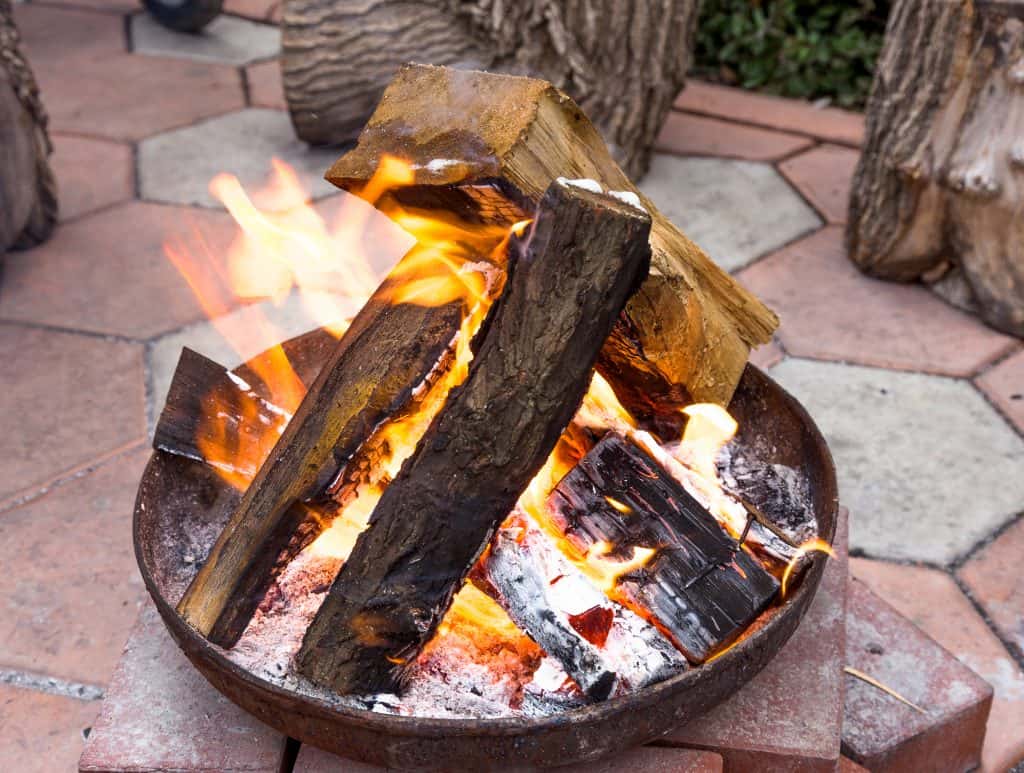
Let’s face it: there’s nothing that truly competes with a real fire’s ambiance. Cozying up around a blazing flame with your loved ones as you roast marshmallows and hot dogs is a pretty unbeatable experience. Campfires are mesmerizing, and you can’t fake that natural crackling sound.
There are some times when fire pits are just essential. Usually, those experiences involve being in the great outdoors surrounded by forests, not in your own backyard.
These days, fire pits don’t just refer to a circle of bricks built to contain the flames. Of course, this is still a great option, but there are more refined alternatives on the market too.
You can now buy fire pit tables or bowls that create a slightly elevated environment. Most of these versions run on propane instead of wood to achieve an adjustable, smoke-free flame. Both of these qualities mean that most people feel comfortable getting closer as the fire is more contained. However, you should still demonstrate caution. It is fire, after all.
Gas and wood fire pits do have many similarities, but their specific benefits and drawbacks differ. We will be strictly referring to wood-burning varieties when we mention fire pits for the rest of this article unless otherwise specified.
Pros of Fire Pits
If you’ve ever sat beside a roaring campfire, you already know about their advantages. Here is a brief refresher:
- Fire pits provide a full sensory experience. When you gather around a campfire, you aren’t doing it just for the warmth. It creates a sense of community between you and those around you. Your other senses also get to indulge too in the lovely smokey smell, the glowing flame’s dancing appearance, the crackling wood audio, and of course, the toasty warmth.
- A campfire’s warmth can’t be beaten. Wood burns at a higher temperature than gas, so fire pits are warmer than other alternatives. This is a great benefit for those chilly outdoor evenings. If you have dry wood and a snow-free pit, you can even start a fire in winter and comfortably gather around it.
- Wood is cheap fuel. Firewood is quite inexpensive, so it’s a cost-effective fuel to use. Depending on where you buy it from, you can usually secure a bundle of firewood for between $5-$7 USD ($6-$9 CAD). If you have any untreated, unpainted scrap wood or recently cut down a tree, you can use that too. Plus, wood is a renewable resource, so you’re helping both your wallet and the environment.
- You’ll achieve the most authentic experience. There’s no doubt that a wood-burning fire pit is the most natural heating experience. If you really want to connect with nature in the great outdoors, this is the way to do so.
- You can construct your own fire pit on a budget. We know that wood is a cheap fuel, but your fire pit’s actual construction can be inexpensive too. All you need to build your own permanent fixture is a steel liner, fire-retardant brick, and a fire ring. If you don’t feel like doing it yourself, there are many high-quality options on the market for under $100 USD ($127 CAD).
- Campfires are multi-functional. Not only do campfires provide superior warmth, but they also double as a rustic cooking appliance. From smokies to Jiffy Pop and s’mores to fried eggs, you can add a little woodsy flair to tons of treats by cooking it over an open flame.
Cons of Fire Pits
Just because you can’t replicate a campfire’s authenticity doesn’t mean they don’t have some setbacks too. Take these into consideration when deciding if a fire pit is right for you:
- Campfires are weather-dependent. When the wind is roaring or rain is falling, there’s a good chance mother nature will cancel your fiery plans. Natural flames are highly susceptible to the elements, so consider your climate before purchasing one. However, you can protect your flame by investing in a Gas Pro Fire Pit Wind Guard to keep the party going even on breezier days.
- You need a steady supply of wood and kindling. To get your fire blazing, you need to have fuel on hand, and not just any kind of wood will do. Only dry, clean, untreated, unpainted, non-salt-laden wood. Keep this on hand in a protected area like under a waterproof tarp or IC IClover Log Rack Cover to keep it safe. Likewise, dried leaves, twigs, and branches make effective kindling to start your fire up.
- Fire pits can be dangerous, especially if left unattended. Unlike gas-powered flames, fire pits burn naturally, which means they can act unpredictably. You can’t adjust the height of a wood-burning flame or just switch it off when you’re done. All fires should be well-attended, but especially these.
- A campfire’s smell clings to clothing and hair. The smokey, burnt firewood smell is quite lovely and relaxing, but it will get trapped in your hair, clothing, and blankets. You’ll have to do a load of laundry and take a shower to get rid of this pesky odor.
- Smoke can be an irritant. Fire fumes irritate many people’s eyes and lungs, resulting in unwanted tears and cough attacks. Remember that just because it doesn’t bother you doesn’t mean it won’t affect those around you. All the more reason not to burn damp wood!
Pyramid Heaters: A Basic Overview
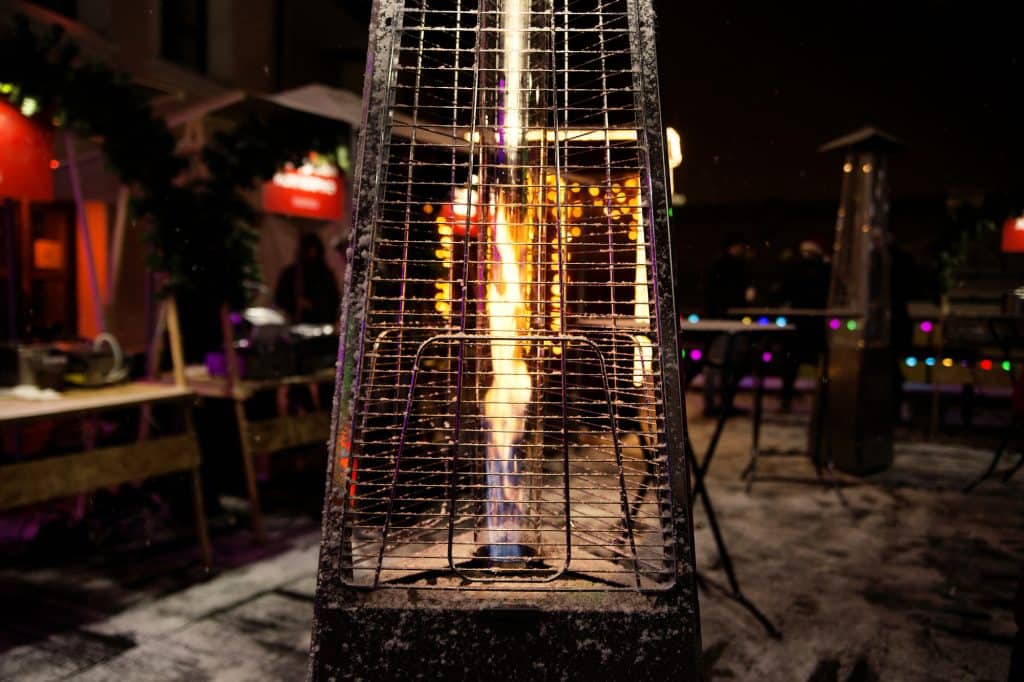
If you’ve sat on a restaurant patio on a brisk summer evening, chances are you’ve felt the warmth of a pyramid heater before. These stylish fixtures not only take the chill off but also add undeniable levels of elevated coziness to the place.
Pyramid heaters live up to their name. They have a wide, solid base that angles towards the top to offer the stability that a standard patio heater lacks. About two-thirds of the way up from the bottom, the solid base turns into a grid-like shield. From here, the flame grows.
The fire may appear open inside its cage confinement, but it’s also held within a glass cylinder. Thanks to its supportive structure, a pyramid heater is unlikely to fall over, and the flame is controllable.
Pros of Pyramid Heaters
Pyramid heaters provide tons of exclusive benefits. Here are some reasons why you might want to start shopping:
- Pyramid heaters have a sleek design. One of the biggest advantages of pyramid heaters is that they’re stunning, modern, and contribute to a cozy-chic ambiance. Unlike patio heaters, pyramids add some serious style points to the atmosphere but are a safer alternative to an open fire-pit.
- Some varieties give off considerable heat. Pyramid heaters are meant to radiate heat over a large piece of ground. That’s the main reason you’ll see them on restaurant patios. Well, that and their attractive aesthetics. Many pyramid heaters dish out around 48,000 BTUs. That means that one of these is suitable for around 960 square feet (89 square meters).
- Many pyramid heaters double as a lantern. Part of the beauty of a pyramid heater is that they essentially hold a self-contained flame. Inside the glass tube that runs vertically through the fixture, you can see the fire dancing around. This adds extra light and sensory enjoyment to the overall experience.
- You can turn them off whenever you want. Unlike wood-burning fires, you can easily switch the burner of a pyramid heater off whenever you’re done with it. You don’t have to dump buckets of water on it to extinguish it or check that all the embers are smothered.
- Pyramid heaters are smokeless. Since pyramids use gas as fuel, there’s no smoke to worry about. You gain many of the benefits of a real fire but lose the irritants and pesky smell. They’re perfect for even the most sensitive guest. It’s a win-win.
- These free-standing warmers are portable. Need to move your pyramid heater around to a different location? No problem. Some of them even come with wheels! As long as your gas is turned off, you can safely transport these heaters from your deck to your poolside. Just double-check that their new home is suitable as per the manufacturer’s instructions.
Cons of Pyramid Heaters
Like all great things, pyramid heaters still have some disadvantages. Take a look at these potential drawbacks:
- They mostly run on non-renewable, expensive gas. While they contribute to a lovely atmosphere, pyramid heaters aren’t great for the earth’s atmosphere. These fixtures burn non-renewable gas as fuel. It’s not only taxing for the climate, but it’s not budget-friendly either.
- Gas-powered devices are easily combustible. A big safety concern with pyramid heaters is that their fuel is dangerously combustible. If used responsibly, this shouldn’t be a problem, but it’s always best to act cautiously when it comes to any heating device.
- Pyramid heaters are used solely for heat. Though pyramid heaters contain a flame, it’s not an open one. This means that you can’t cook over these warmers or enjoy the sound of a crackling fire, unlike a fire pit. Still, they produce a lot of heat, so be careful not to touch them.
- They have a bigger footprint than patio heaters. The sturdy base of a pyramid heater makes it harder in the wind, but that also means you’ll have to sacrifice some space. If you have ground to give up, then this won’t be a problem for you. Plus, you shouldn’t be using one of these in small areas anyway.
- May not be weather-proof. Depending on the make of your pyramid heater, it may not stand up to all that mother nature sends its way. Many pyramids do alright in most kinds of weather, but it’s best to check the directions carefully before use.
Which Is Right for You?
- Is safety a big concern? Some heating options like fire pits and patio heaters can pose a pretty substantial safety threat if people are behaving recklessly near them. If you know you’ll have kids running around, intoxicated adults wandering nearby, or even a large playful dog, a pyramid heater is the safer option.
- What will be its primary function? Do you envision gathering around outside in a communal area singing songs and cooking food? If so, it sounds like a fire pit is right for you. If you solely want warmth over a large area, a patio or pyramid heater will work better.
- How much space do you need to cover? Wood burns hotter than gas, making fire pits a more suitable choice for ramping up lots of heat in a small area. However, a fire’s warmth doesn’t cover much ground. If you’re heating a large area, one or more patio or pyramid heaters will be your best choice.
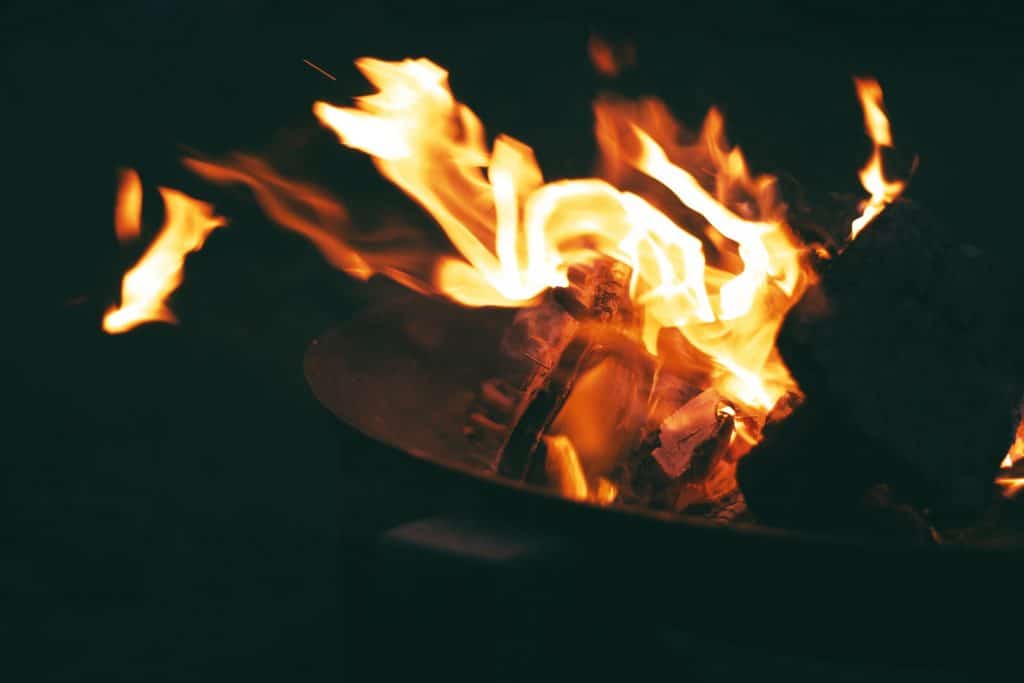
Final Thoughts
Patio heaters and fire pits both offer unique benefits, but pyramid heaters are the ideal choice for most people. These models provide substantial warmth over a large area, don’t pose the threat of an open flame, and have a sturdy, stylish design.
Still, if you’re looking to roast up some marshmallows, get that good old crackling sound, and achieve that wood-burning scent, there’s nothing quite like a fire pit.

